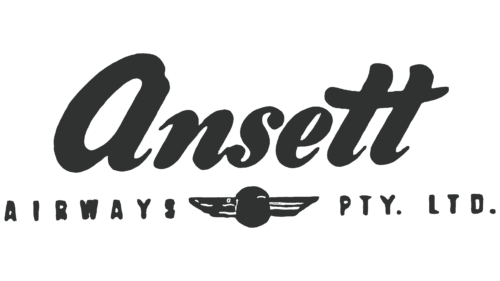Throughout its history, Ansett Australia’s logo has mirrored various aspects of its identity, showcasing its heritage and business ethos. As a major player in Australian aviation, the company was deeply integrated into the nation’s fabric, a concept elegantly symbolized by its logo. The design conveyed a sense of reliability and comprehensive service, reflecting the airline’s commitment to offering extensive domestic and international routes.
Ansett Australia: Brand overview
The airline, founded by Reg Ansett, began operations on 17 February 1936 in Melbourne with a single six-seater Fokker Universal aircraft. On its maiden flight, February 6, 1936, it flew from Melbourne to Hamilton. By 1939, the company had expanded its fleet to include six Fokker F.VII and Douglas DC-2 aircraft, creating a network that connected Melbourne to various cities and towns throughout Victoria.
After World War II, the Australian government took over the airline’s control in 1946, renaming it Australian National Airways (ANA). The fleet was updated with larger Douglas DC-3 and Douglas DC-4 aircraft. In 1957, it changed its name to Trans Australia Airlines (TAA) and began flying jet aircraft such as the Boeing 727, Douglas DC-9, and Lockheed L-188 Electra, expanding its domestic and Southeast Asian routes.
In the 1970s, it was privatized and bought back by the Ansett family, reverting to its original name, Ansett Airways, in 1971. It now offers international flights.
By the late 1990s, the company was experiencing financial difficulties due to high costs and debt. The situation worsened after the September 11 terrorist attacks, which seriously affected the aviation market. Unable to cope with financial difficulties, it ceased operations on September 13, 2001.
A month after the closure, a group of private investors attempted to revive the airline under the name Ansett Australia Mark II. Despite their best efforts, they could not overcome the problems in the aviation market after 2001. The new company operated for about six months until its final flight on 4 March 2002 from Melbourne to Sydney, when it closed.
Meaning and History
What is Ansett Australia?
It was a major Australian airline that operated domestic and international flights. It was known for providing comprehensive air transportation services, connecting major cities and regional destinations in Australia and various international routes. The company offered various services, including economy and business class, focusing on passenger comfort and reliability. The airline ceased operations due to financial difficulties. Its closure marked the end of an era in the history of Australian air transportation.
1950s
Ansett Australia was established in the 1950s, and its initial logo displayed an ambitious aspiration to establish itself in the air transport market. The logo design’s unique use of fonts and symbols is intended to visually reflect the company’s confidence and professionalism.
The large letters of the company name are in uppercase, creating a visual effect of a harmonious dance. This design choice emphasizes smoothness and fluidity, which are essential in the aviation industry. Each letter is meticulously formed to convey a sense of confidence and stability, which is crucial for a company that transports passengers.
The prominent letter “A” at the beginning of the name is balanced with two “t” s at the end. This symmetry in the logo enhances the feeling of stability and balance, which helps highlight the company’s reliability and resilience.
The logo’s center features a propeller symbol, emphasizing the company’s focus on aviation. Propellers represent movement and innovation, and their placement underscores their importance as a key brand element.
Registration information is discreetly added to the left and right of the central part of the logo. These small details contribute to the visual balance and introduce an element of legality and formality, strengthening the company’s image as a fully licensed and reliable air carrier.
1968 – 1981
Following a strategic merger with a major competitor, the carrier solidified its market position in Western Australia. This significant moment in the company’s history is captured in the redesign of its logo, where two folded red pennants form the image of a central rocket figure. This symbolism intentionally represents the dynamism and assertiveness of the company’s operations.
The central rocket figure in the logo symbolizes rapid ascending motion, highlighting the company’s ambitions and leadership qualities. The rocket, symbolizing a swift and powerful rise, perfectly mirrors the company at the peak of its development. The visual integration of two pennants into a single cohesive structure emphasizes the recent merger and the creation of a new, harmonious tandem that has fortified the positions of both entities.
The choice of red for the logo is deliberate. Red is associated with energy, passion, and power. This shade is traditionally used to attract attention and emphasize significance and relevance. In the logo’s context, the red color enhances the sense of dynamism and activity, highlighting the company’s leadership ambitions and drive to dominate the market.
1981 – 1990
Ansett Australia has undergone significant changes in its image, becoming an icon of the aviation industry both within Australia and internationally. Over the years, the Ansett brand has evolved into a cult name, leaving an indelible mark on the continent’s aviation history. The company’s fame and reputation have reached such heights that it has become synonymous with high quality and reliability in air transport.
The new logo design reflects this unique market position. Simplicity and elegance are key elements: the company name is adorned with just a concise dot, emphasizing the brand’s completeness and self-sufficiency. This minimalist approach indicates that Ansett does not need excessive display or additional embellishments—its name alone guarantees quality and recognition.
Ansett has established itself as the foremost carrier on the continent, and it is known to everyone. The choice of deep blue in the logo reinforces its market dominance and high level of recognition. This color is traditionally associated with professionalism, reliability, and solidity—qualities that form the basis of Ansett’s image. The blue adds gravitas to the logo and underscores the company’s commitment to maintaining high standards in everything it does.
1990 – 1994
In the 1990s, amid significant legislative changes related to the liberalization of the aviation industry, Ansett Australia actively entered the competitive arena. Bold and decisive actions marked this period to expand its influence in the Australian aviation space. Ansett adapted to the new market conditions and actively used them to strengthen its position by acquiring competitors and forming an effective network of subsidiaries. These strategic moves allowed Ansett to create a comprehensive network of routes serving the entire continent, offering passengers a wide range of travel options.
The company’s brand image was updated to reflect these significant changes in strategy and status. The Ansett Australia logo was modified to reflect the company’s new role as a dominant air carrier. While the main design elements, such as font and color, were retained to maintain brand recognition and continuity, the logo was expanded to include the full name “Ansett Australia.” This change emphasized the national scale of operations and the company’s ambitions to be a market leader.
The final element of the new logo was a bold dot after the name, symbolizing confidence and the completion of the company’s transformation stage. This mark underscores Ansett Australia’s determination and authority, signaling the completion of one development phase and readiness for new achievements.
1994 – 2002
The Ansett Australia logo, introduced in 1994 and used until the company went bankrupt, combines national identity and corporate ambition. The top part of the logo features a stylized letter “A” without a traditional crossbar, instead incorporating a seven-pointed white star, similar to the one on the Australian flag. The “A” has an elongated shape, evoking the grandeur of a mountain peak. The two diagonal lines forming the “A” are in a rich golden gradient, set against a background of two shades of blue that merge in a square base, symbolizing the ocean and the country’s flag.
Below this graphic is the brand name, written in a unique font that ensures it stands out. This font reflects the company’s ambition to differentiate itself in a competitive airline market.
The golden gradient on the letter “A” suggests luxury and excellence, hinting at the high-quality service Ansett Australia aims to provide. The blue background connects the logo to the national flag and symbolizes the vast oceans surrounding Australia, reinforcing the company’s national identity.
The seven-pointed star within the “A” directly references the Australian flag, adding a layer of patriotism and emphasizing the airline’s Australian roots. The elongated shape of the “A,” resembling a mountain peak, conveys ambition and striving for excellence, reflecting the airline’s goals.
FAQ
Why did Ansett Australia collapse?
The company went out of business due to problems that worsened over time, affecting the airline’s money and operations. Here are the main reasons for failure:
- The company faced stiff competition from Qantas, Australia’s main airline, which was more established and financially stronger. The situation has become even more complicated with the entry of low-cost airlines such as Impulse Airlines and Virgin Blue, which Virgin Australia now owns. They offered cheaper tickets, attracting many of the company’s customers. This forced prices to cut, cutting into its profits. It had high costs because it had too many managers and paid its employees more than its competitors. This made it difficult to make money or be as profitable as newer, more efficient airlines.
- The company’s planes were older and more expensive to operate and maintain than the newer planes its competitors used. This has increased maintenance costs and made it harder to stay competitive. Maintenance problems with aircraft, especially Boeing 767s, added to the problems. These problems raised safety concerns and led to some planes being grounded, severely reducing the number of flights the company could operate and the revenue it could generate. Unable to turn the tide or quickly adapt to a changing market, the company went out of business in 2001.
Is Ansett Australia still operating?
A major airline based in Melbourne is no longer in business. It ceased flying in 2001 after 65 years of service. The company once played a pivotal role in the Australian aviation industry, offering flights throughout Australia from the 1990s to various destinations in Asia. Towards the end of its operation, it faced several problems, including financial problems and strong competition, making it difficult to continue operating.
What country is Ansett Australia for?
The company is headquartered in Melbourne. It played a significant role in the country’s aviation industry, providing extensive flights throughout Australia and expanding into international routes, particularly in Asia, from the 1990s. It has played an important role in connecting cities across Australia and its international connections with other countries. It remained Australia’s flagship airline until it ceased operations in 2002.









